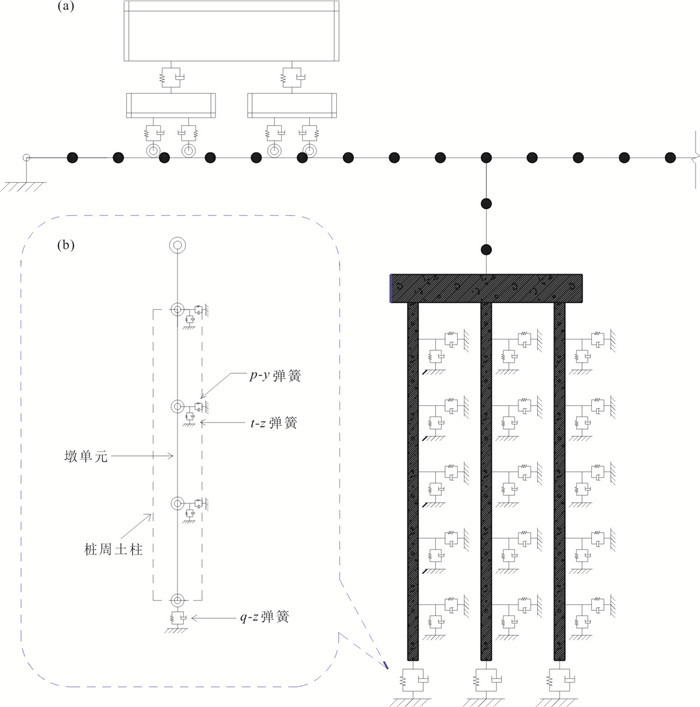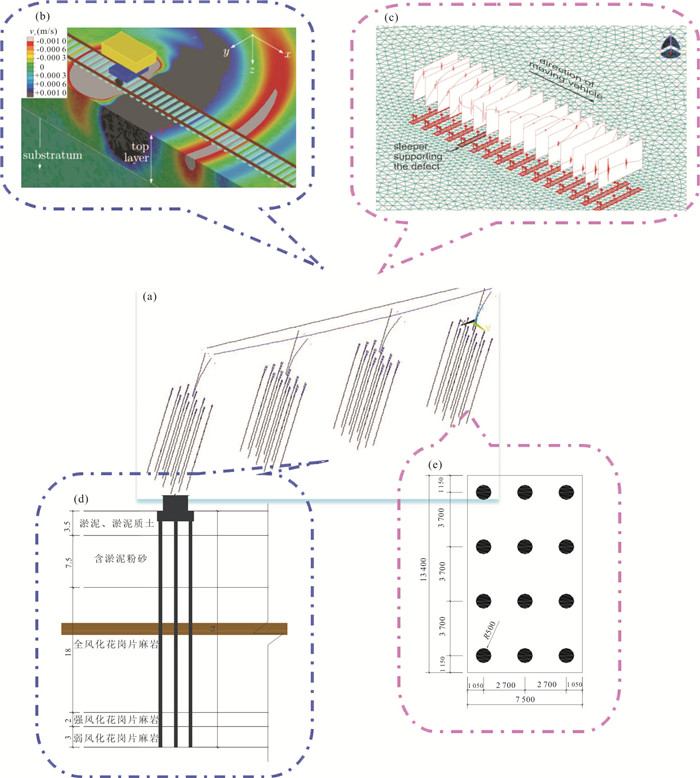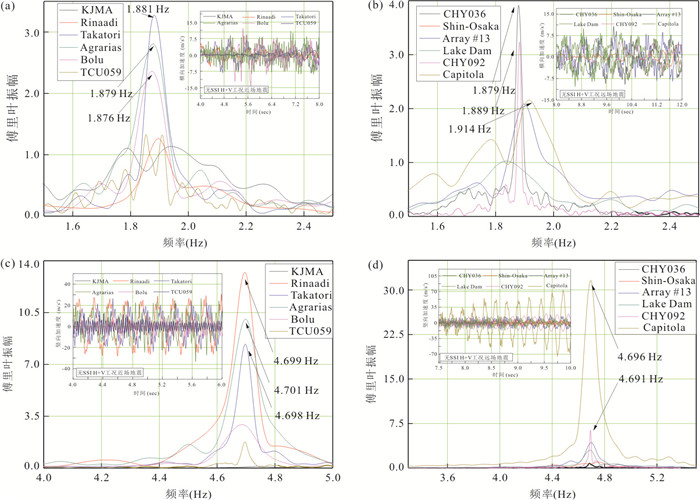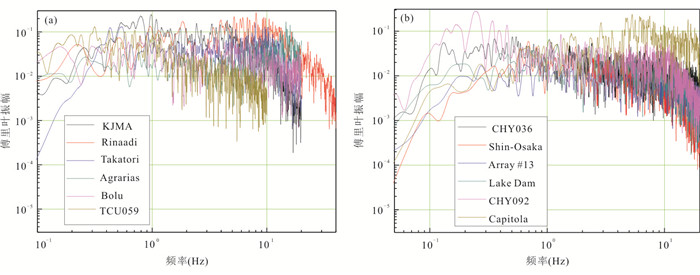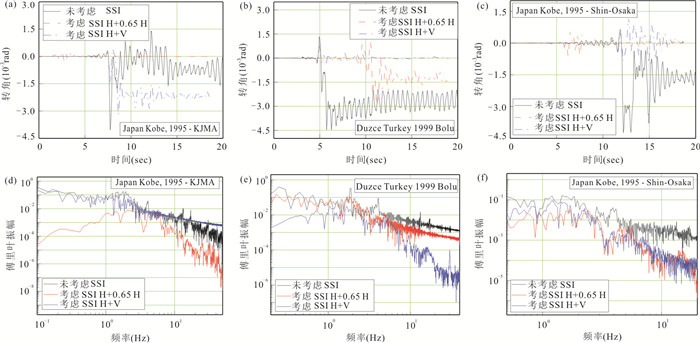Seismic Response of Railway Bridges in Active Complex Tectonic Zones Part Ⅱ: Effects of SSI (Soil-Structure Interaction)
-
摘要:
目前国家正在复杂艰险构造区修建和规划新的铁路,地震等极限环境耦合作用对铁路交通的影响受到越来越多的关注.本文提出一种列车‒桥梁‒土耦合系统的数值模型,引入车辆简化模型、桥梁结构非线性有限元模型和层状土半解析模型,采用纯时域求解方法.利用p-y曲线、t-z曲线和q-z曲线建立土‒桩基非线性模型,采用双线性模型模拟桥墩及桩基础的滞回特性,计算不良地质体发育区铁路列车‒桥梁‒土耦合系统的弹塑性地震响应,分析SSI对桥梁弹塑性地震响应的影响.研究表明,列车‒桥梁‒土耦合系统的第一弯曲模态通常是临界模态,即梁的一个半波形状导致土桥系统固有频率降低.另外,对于横向地震响应来说,考虑SSI(土‒结构相互作用)后,影响地震响应的频率成分会发生变化,除了频率会变小之外,频段也会变宽.考虑SSI之前,影响频段是1.8~2.0 Hz,考虑SSI之后变为1.2~2.0 Hz之间.对于梁跨中竖向加速度,从考虑SSI之前的4.576 Hz到考虑SSI之后的14.215 Hz,建议考虑SSI进行设计时候应考虑竖向高阶振型影响.
Abstract:When constructing new railways in challenging tectonic zones, the influence of harsh situations like earthquakes on train traffic is increasingly being considered. With a time-domain solution approach, a numerical model of the coupled train-bridge-soil system is provided. In the poor geological development area, the elastic-plastic seismic response of the railroad train-bridge-soil coupled system is calculated using the p-y, t-z, and q-z curves. This means that bending the beam half-wave form reduces the inherent frequency of the coupled train-bridge-soil system, which is discovered to be the initial bending mode. After taking into account soil-structure interaction (SSI), the frequency components impacting the seismic response vary, and the frequency range widens as well as decreasing. The affecting frequency range is 1.8-2.0 Hz before SSI and 1.2-2.0 Hz after SSI, respectively. To design SSI, it is advised that the influence of vertical higher order vibration pattern should be addressed, since it varies from 4.576 Hz to 14.215 Hz before and after SSI consideration.
-
图 8 近场/远场非脉冲地震墩底第1单元转角时程图及其对应的傅里叶谱图
时程图:a. Kobe 1995地震KJMA波地震;b. Duzce 1999地震Bolu波;c. Kobe 1995地震Shin-Osaka波. 傅里叶谱图:d. Kobe 1995地震KJMA波地震;e. Duzce 1999地震Bolu波;f. Kobe 1995地震Shin-Osaka波
Fig. 8. Rotation angle time-history diagrams and its corresponding Fourier spectra at first element of the pier bottom subjected to the NF/FF ground motions
表 1 脉冲近场地震
Table 1. Pulse-typed near-fault ground motion database
地震名称 台站 震级 断层距(km) 场地 Tp
(s)PGAH
(g)PGVH (cm/s) PGAV
(g)$ {\partial }_{PGA} $ Ap/
vpKobe 1995 KJMA 6.9 1.0 粘土 1.09 0.854 105.6 0.342 0.401 8.08 Northridge1994 Rinaadi 6.7 0.0 粘土 1.25 0.869 149.0 0.834 0.959 5.84 Kobe 1995 Takatori 6.9 1.4 粘土 1.55 0.682 153.2 0.271 0.398 4.45 Imperial Valley06 1979 Agrarias 6.53 0.6 粘土 2.34 0.311 53.5 0.834 2.679 5.82 Duzce 1999 Bolu 7.1 6.6 粘土 5.94 0.775 65.8 0.202 0.261 11.79 Chi-Chi 1999 TCU059 7.62 3.6 粘土 7.78 0.168 64.1 0.056 0.334 2.63 注:Tp为脉冲周期;PGAH为横向峰值地震加速度;PGVH为横向峰值地震速度;PGAV为竖向峰值地震加速度;竖向峰值地震加速度与横向峰值地震加速度比值$ {\partial }_{PGA}=PG{A}_{\mathrm{V}}/PG{A}_{\mathrm{H}} $;Ap/vp是横向峰值加速度与横向峰值速度的比值. 表 2 远场非脉冲地震
Table 2. Far field ground motion database
地震名称 台站 震级 断层(km) 场地 PGAH
(g)PGVH (cm/s) PGAV
(g)$ {\partial }_{PGA} $ Ap/
vpChi-Chi 1999 CHY036 7.6 16.1 粘土 0.322 36.31 0.104 0.322 8.89 Kobe 1995 Shin-Osaka 6.9 19.2 粘土 0.186 29.96 0.058 0.314 6.23 Imperial Valley 1979 El Centro Array #13 6.5 21.9 粘土 0.138 14.23 0.045 0.330 9.70 Loma Prieta 1989 Coyote Lake Dam (Downst) 6.9 20.8 粘土 0.159 10.30 0.0947 0.593 15.50 Chi-Chi 1999 CHY092 7.6 22.7 粘土 0.111 60.71 0.119 1.076 1.83 Loma Prieta 1989 Capitola 6.9 15.2 粘土 0.371 34.55 0.541 1.455 10.75 表 3 桥墩/桩柱弯矩‒曲率骨架曲线响应计算值
Table 3. Calculated value of skeleton-frame curves of moment-curvature relation of pier/pile
地震方向 屈服转角(10-3 rad) 屈服弯矩(103 kN·m) 极限转角(10-3 rad) 极限弯矩(103 kN·m) 桥墩 横桥向 0.47 56.40 17.87 97.90 顺桥向 1.45 24.80 52.63 35.80 桩柱 横桥向 2.10 5.51 47.50 6.42 顺桥向 2.18 5.71 44.30 6.96 表 4 地质参数
Table 4. Soil column properties
层序号 到桩顶距离(m) 土层厚度(m) 岩土名称 密度
(g/cm3)剪切波速
(m/s)泊松比 剪切模量(MPa) 弹性模量(MPa) 1 0~3.5 3.5 淤泥、淤泥质土 1.85 85 0.46 13.37 49.47 2 3.5~11.0 7.5 含淤泥粉砂 1.94 191 0.35 70.77 274.59 3 11~29 18 全风化花岗片麻岩 2.05 311 0.27 198.28 812.95 4 29~31 2 强风化花岗片麻岩 2.00 1 200 0.25 2 880 11 250 5 31~34 3 弱风化花岗片麻岩 2.10 1 500 0.22 4 725 16 601 -
Abd-Elhamed, A., Mahmoud, S., 2019. Simulation Analysis of TMD Controlled Building Subjected to Far- and Near-Fault Records Considering Soil-Structure Interaction. Journal of Building Engineering, 26: 100930. https://doi.org/10.1016/j.jobe.2019.100930 Bhure, H., Sidh, G., Gharad, A., 2018. Dynamic Analysis of Metro Rail Bridge Subjected to Moving Loads Considering Soil-Structure Interaction. International Journal of Advanced Structural Engineering, 10(3): 285-294. https://doi.org/10.1007/s40091-018-0198-9 Bucinskas, P., Andersen, L. V., 2020. Dynamic Response of Vehicle-Bridge-Soil System Using Lumped-Parameter Models for Structure-Soil Interaction. Computers & Structures, 238: 106270. https://doi.org/10.1016/j.compstruc.2020.106270 Chen, L. K., 2012. Seismic Responses of High-Speed Railway Train-Ballastless Track-Bridge System and Train-Running Safety during Earthquake (Dissertation). Central South University, Changsha (in Chinese with English abstract). Chen, Z. W., Han, Z. L., Zhai, W. M., et al., 2019. TMD Design for Seismic Vibration Control of High-Pier Bridges in Sichuan-Tibet Railway and Its Influence on Running Trains. Vehicle System Dynamics, 57(2): 207-225. https://doi.org/10.1080/00423114.2018.1457793 Dammala, P. K., Bhattacharya, S., Krishna, A. M., et al., 2017. Scenario Based Seismic Re-Qualification of Caisson Supported Major Bridges-A Case Study of Saraighat Bridge. Soil Dynamics and Earthquake Engineering, 100: 270-275. https://doi.org/10.1016/j.soildyn.2017.06.005 Dash, S., Rouholamin, M., Lombardi, D., et al., 2017. A Practical Method for Construction of p-y Curves for Liquefiable Soils. Soil Dynamics and Earthquake Engineering, 97: 478-481. https://doi.org/10.1016/j.soildyn.2017.03.002 FEMA P695, 2009. "Quantification of Building Seismic Performance Factors" Rep. FEMA P695, Federal Emergency Management Agency, Washington, D.C. . Gao, M. M., 2002. Studies on Train-Track-Bridge Coupling Vibration and Train Performance on High-Speed Railway Bridges (Dissertation). China Academy of Railway Sciences, Beijing (in Chinese with English abstract). Galvín, P., Romero, A., Moliner, E., et al., 2021. Fast Simulation of Railway Bridge Dynamics Accounting for Soil-Structure Interaction. Bulletin of Earthquake Engineering, Online. https://doi.org/10.1007/s10518-021-01191-0 Hu, G. S., Zhao, C. Y., Chen, N. S., et al., 2019. Characteristics, Mechanisms and Prevention Modes of Debris Flows in an Arid Seismically Active Region along the Sichuan-Tibet Railway Route, China: A Case Study of the Basu-Ranwu Section, Southeastern Tibet. Environmental Earth Sciences, 78(18): 1-18. https://doi.org/10.1007/s12665-019-8554-z Idriss, I. M., Sun, J. I., 1993. User's Manual for SHAKE91: A Computer Program for Conducting Equivalent Linear Seismic Response Analyses of Horizontally Layered Soil Deposits. Center for Geotechnical Modeling, Department of Civil and Environmental Engineering, University of California, Davis. Jeong, S., Bradley, B. A., 2017. Amplification of Strong Ground Motions at Heathcote Valley during the 2010-2011 Canterbury Earthquakes: Observation and 1D Site Response Analysis. Soil Dynamics and Earthquake Engineering, 100: 345-356. https://doi.org/10.1016/j.soildyn.2017.06.004 Ju, S. H., Hung, S. J., 2019. Derailment of a Train Moving on Bridge during Earthquake Considering Soil Liquefaction. Soil Dynamics and Earthquake Engineering, 123: 185-192. https://doi.org/10.1016/j.soildyn.2019.04.019 Li, P. E., Liao, L., Feng, J. Z., 2021. Study on Relationship between Stress Evolution and Aftershocks after the Changning M6.0 Earthquake in Sichuan on 17 June 2019. Earth Science, Online (in Chinese with English abstrat). https://doi.org/10.3799/dqkx.2021.143 Li, Y., Conte, J. P., 2016. Effects of Seismic Isolation on the Seismic Response of a California High-Speed Rail Prototype Bridge with Soil-Structure and Track-Structure Interactions. Earthquake Engineering & Structural Dynamics, 45(15): 2415-2434. https://doi.org/10.1002/eqe.2770 Lu, C. F., Cai, C. X., 2019. Challenges and Countermeasures for Construction Safety during the Sichuan-Tibet Railway Project. Engineering, 5(5): 833-838. https://doi.org/10.1016/j.eng.2019.06.007 Luo, C., Yang, X., Zhan, C., et al., 2016. Nonlinear 3D Finite Element Analysis of Soil-Pile-Structure Interaction System Subjected to Horizontal Earthquake Excitation. Soil Dynamics and Earthquake Engineering, 84: 145-156. https://doi.org/10.1016/j.soildyn.2016.02.005. Ministry of Railways of the People's Republic of China, 2009. Code for Seismic Design of Railway Engineering (GB50111-2006). China Planning Press, Beijing (in Chinese). Mohanty, P., Dutta, S. C., Bhattacharya, S., 2017. Proposed Mechanism for Mid-Span Failure of Pile Supported River Bridges during Seismic Liquefaction. Soil Dynamics and Earthquake Engineering, 102: 41-45. https://doi.org/10.1016/j.soildyn.2017.08.013 Pan, J.Y., Gao, M.M., 2008. Dynamic Analysis of Railroad Train-Line-Bridge System. China Railway Publishing House, Beijing (in Chinese). Penzien, J., Watabe, M., 1974. Characteristics of 3‐Dimensional Earthquake Ground Motions. Earthquake Engineering & Structural Dynamics, 3(4): 365-373. https://doi.org/10.1002/eqe.4290030407 Rachedi, M., Matallah, M., Kotronis, P., 2021. Seismic Behavior & Risk Assessment of an Existing Bridge Considering Soil-Structure Interaction Using Artificial Neural Networks. Engineering Structures, 232: 111800. https://doi.org/10.1016/j.engstruct.2020.111800 Shi, L., Sun, H. L., Pan, X. D., et al., 2019. A Theoretical Investigation on Characteristic Frequencies of Ground Vibrations Induced by Elevated High Speed Train. Engineering Geology, 252: 14-26. https://doi.org/10.1016/j.enggeo.2019.02.014 Sun, L. X., Wang, Y., Yang, J., et al., 2021. Progress in Rotational Seismology. Earth Science, 46(4): 1518-1536 (in Chinese with English abstrat). Wang, Z. H., Dueñas-Osorio, L., Padgett, J. E., 2013. Seismic Response of a Bridge-Soil-Foundation System under the Combined Effect of Vertical and Horizontal Ground Motions. Earthquake Engineering & Structural Dynamics, 42(4): 545-564. https://doi.org/10.1002/eqe.2226 Wang, X. W., Li, Z. Q., Shafieezadeh, A., 2021. Seismic Response Prediction and Variable Importance Analysis of Extended Pile-Shaft-Supported Bridges Against Lateral Spreading: Exploring Optimized Machine Learning Models. Engineering Structures, 236: 112142. https://doi.org/10.1016/j.engstruct.2021.112142 Wu, R. A., Zhang, Y. S., Guo, C. B., et al., 2020. Landslide Susceptibility Assessment in Mountainous Area: A Case Study of Sichuan-Tibet Railway, China. Environmental Earth Sciences, 79(6): 1-16. https://doi.org/10.1007/s12665-020-8878-8 Yu, K. Y., Gu, X. Q., Huang, M. S., et al., 2021. Experimental, Numerical and Analytical Studies on the Attenuation of Maglev Train-Induced Vibrations with Depth in Layered Soils. Soil Dynamics and Earthquake Engineering, 143: 106628. https://doi.org/10.1016/j.soildyn.2021.106628 Yu, X. Z., Mou, R. F., 2021. System Modeling and Risk Analysis of the Sichuan-Tibet Railway Project. Journal of Transportation Engineering, Part A: Systems, 147(12): 04021094. https://doi.org/10.1061/jtepbs.0000610 Zhang, J., Xie, Y. Z., Wu, G., 2019. Seismic Responses of Bridges with Rocking Column-Foundation: A Dimensionless Regression Analysis. Earthquake Engineering & Structural Dynamics, 48(1): 152-170. https://doi.org/10.1002/eqe.3129 Zhang, J. M., Zhu, W., Cheng, Y. Q., et al., 2021. Landslide Detection in the Linzhi-Ya'an Section along the Sichuan-Tibet Railway Based on InSAR and Hot Spot Analysis Methods. Remote Sensing, 13(18): 3566. https://doi.org/10.3390/rs13183566 Zhao, M. Y., Xie, Q., Ren, X. H., et al., 2020. Experimental Research on the Deformation and Failure Characteristics of Coarse-Grained Soil Slopes in Seasonal Frozen Region along Sichuan-Tibet Railway. IOP Conference Series: Earth and Environmental Science, 455(1): 012135. https://doi.org/10.1088/1755-1315/455/1/012135 Zhao, W. T., Ding, J. M., Zhang, Q. S., et al., 2021. Investigation into the Braking Performance of High-Speed Trains in the Complex Braking Environment of the Sichuan-Tibet Railway. Proceedings of the Institution of Mechanical Engineers, Part F: Journal of Rail and Rapid Transit, 095440972110418. https://doi.org/10.1177/09544097211041884 陈令坤, 2012. 地震作用下高速铁路列车‒无砟轨道‒桥梁系统动力响应及走行安全研究(博士学位论文). 长沙: 中南大学. 高芒芒, 2002. 高速铁路列车‒线路‒桥梁耦合振动及列车走行性研究(博士学位论文). 北京: 中国铁道科学研究院. 李平恩, 廖力, 奉建州, 2021. 2019年6月17日四川长宁6.0级地震震后应力演化与余震关系研究. 地球科学, 在线发表. https://doi.org/10.3799/dqkx.2021.143 中华人民共和国铁道部, 2009. 铁路工程抗震设计规范(GB50111-2006). 北京: 中国计划出版社. 潘家英, 高芒芒, 2008. 铁路车‒线‒桥系统动力分析. 北京: 中国铁道出版社. 孙丽霞, 王赟, 杨军, 等, 2021. 旋转地震学的研究进展. 地球科学, 46(4): 1518-1536. doi: 10.3799/dqkx.2020.113 -










 下载:
下载:
